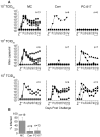Efficacy of Carraguard-based microbicides in vivo despite variable in vitro activity
- PMID: 18776937
- PMCID: PMC2525816
- DOI: 10.1371/journal.pone.0003162
Efficacy of Carraguard-based microbicides in vivo despite variable in vitro activity
Abstract
Anti-HIV microbicides are being investigated in clinical trials and understanding how promising strategies work, coincident with demonstrating efficacy in vivo, is central to advancing new generation microbicides. We evaluated Carraguard and a new generation Carraguard-based formulation containing the non-nucleoside reverse transcriptase inhibitor (NNRTI) MIV-150 (PC-817). Since dendritic cells (DCs) are believed to be important in HIV transmission, the formulations were tested for the ability to limit DC-driven infection in vitro versus vaginal infection of macaques with RT-SHIV (SIVmac239 bearing HIV reverse transcriptase). Carraguard showed limited activity against cell-free and mature DC-driven RT-SHIV infections and, surprisingly, low doses of Carraguard enhanced infection. However, nanomolar amounts of MIV-150 overcame enhancement and blocked DC-transmitted infection. In contrast, Carraguard impeded infection of immature DCs coincident with DC maturation. Despite this variable activity in vitro, Carraguard and PC-817 prevented vaginal transmission of RT-SHIV when applied 30 min prior to challenge. PC-817 appeared no more effective than Carraguard in vivo, due to the limited activity of a single dose of MIV-150 and the dominant barrier effect of Carraguard. However, 3 doses of MIV-150 in placebo gel at and around challenge limited vaginal infection, demonstrating the potential activity of a topically applied NNRTI. These data demonstrate discordant observations when comparing in vitro and in vivo efficacy of Carraguard-based microbicides, highlighting the difficulties in testing putative anti-viral strategies in vitro to predict in vivo activity. This work also underscores the potential of Carraguard-based formulations for the delivery of anti-viral drugs to prevent vaginal HIV infection.
Conflict of interest statement
Figures






Similar articles
-
Exposure to MIV-150 from a high-dose intravaginal ring results in limited emergence of drug resistance mutations in SHIV-RT infected rhesus macaques.PLoS One. 2014 Feb 27;9(2):e89300. doi: 10.1371/journal.pone.0089300. eCollection 2014. PLoS One. 2014. PMID: 24586674 Free PMC article.
-
The nonnucleoside reverse transcriptase inhibitor MIV-150 in carrageenan gel prevents rectal transmission of simian/human immunodeficiency virus infection in macaques.J Virol. 2011 Jun;85(11):5504-12. doi: 10.1128/JVI.02422-10. Epub 2011 Mar 16. J Virol. 2011. PMID: 21411526 Free PMC article.
-
Carrageenan/MIV-150 (PC-815), a combination microbicide.Sex Transm Dis. 2007 Jan;34(1):9-14. doi: 10.1097/01.olq.0000223287.46097.4b. Sex Transm Dis. 2007. PMID: 16924181
-
Clinical development of microbicides for the prevention of HIV infection.Curr Pharm Des. 2004;10(3):315-36. doi: 10.2174/1381612043386374. Curr Pharm Des. 2004. PMID: 14754390 Review.
-
Dawn of non-nucleoside inhibitor-based anti-HIV microbicides.J Antimicrob Chemother. 2006 Mar;57(3):411-23. doi: 10.1093/jac/dki464. Epub 2006 Jan 23. J Antimicrob Chemother. 2006. PMID: 16431862 Review.
Cited by
-
Semi-solid gels function as physical barriers to human immunodeficiency virus transport in vitro.Antiviral Res. 2010 Nov;88(2):143-51. doi: 10.1016/j.antiviral.2010.08.006. Epub 2010 Aug 13. Antiviral Res. 2010. PMID: 20709109 Free PMC article.
-
Short communication: a repeated simian human immunodeficiency virus reverse transcriptase/herpes simplex virus type 2 cochallenge macaque model for the evaluation of microbicides.AIDS Res Hum Retroviruses. 2014 Nov;30(11):1117-24. doi: 10.1089/aid.2014.0207. AIDS Res Hum Retroviruses. 2014. PMID: 25354024 Free PMC article.
-
A MIV-150/zinc acetate gel inhibits SHIV-RT infection in macaque vaginal explants.PLoS One. 2014 Sep 26;9(9):e108109. doi: 10.1371/journal.pone.0108109. eCollection 2014. PLoS One. 2014. PMID: 25259616 Free PMC article.
-
Novel RNA Duplex Locks HIV-1 in a Latent State via Chromatin-mediated Transcriptional Silencing.Mol Ther Nucleic Acids. 2015 Oct 27;4(10):e261. doi: 10.1038/mtna.2015.31. Mol Ther Nucleic Acids. 2015. PMID: 26506039 Free PMC article.
-
Exposure to MIV-150 from a high-dose intravaginal ring results in limited emergence of drug resistance mutations in SHIV-RT infected rhesus macaques.PLoS One. 2014 Feb 27;9(2):e89300. doi: 10.1371/journal.pone.0089300. eCollection 2014. PLoS One. 2014. PMID: 24586674 Free PMC article.
References
-
- DiClemente RJ, Wingood GM, Harrington KF, Lang DL, Davies SL, et al. Efficacy of an HIV prevention intervention for African American adolescent girls: a randomized controlled trial. Jama. 2004;292:171–179. - PubMed
-
- Gregson S, Garnett GP, Nyamukapa CA, Hallett TB, Lewis JJ, et al. HIV decline associated with behavior change in eastern Zimbabwe. Science. 2006;311:664–666. - PubMed
-
- Stoneburner RL, Low-Beer D. Population-level HIV declines and behavioral risk avoidance in Uganda. Science. 2004;304:714–718. - PubMed
-
- Shattock RJ, Moore JP. Inhibiting sexual transmission of HIV-1 infection. Nat Rev Microbiol. 2003;1:25–34. - PubMed
-
- From the Centers of Disease Control and Prevention. CDC statement on study results of product containing nonoxynol-9. Jama. 2000;284:1376. - PubMed
Publication types
MeSH terms
Substances
Grants and funding
LinkOut - more resources
Full Text Sources

